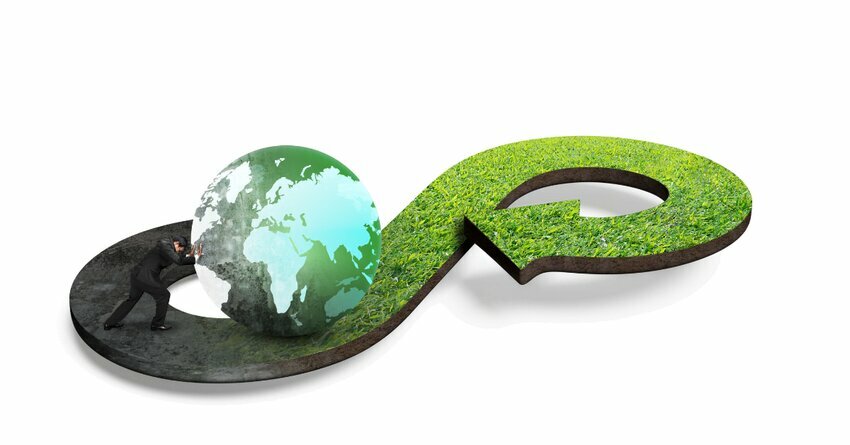 (Credit: Canva Pro)
(Credit: Canva Pro)Amidst the pressing ecological issues our planet confronts, including climate change and resource depletion, there is an increasing acknowledgment of the urgency for a sustainable and circular economy. Such an economy operates on restorative and regenerative principles, emphasizing the maximization of material usage and the reduction of waste.
At the forefront of the circular economy movement is the Ellen MacArthur Foundation, a prominent institution that has devised a flexible and adaptable approach to circular design. This approach seeks to provide designers and businesses with a framework for integrating circular design principles into their operations.
The Ellen MacArthur Foundation has identified six focus areas, called design leverage points, that can create an organizational environment for circular transformation. These points have been developed with input from design leaders in various sectors, and are meant to provide strategies for those leading circular design efforts.
The emphasis of this field is on acquiring a thorough comprehension of the environment and frameworks in which a product or service will be employed. This necessitates scrutinizing and deciphering user actions and requirements, as well as more extensive societal, economic, and environmental aspects. This approach enables designers to detect possibilities for circular and sustainable alternatives, as well as possible impediments and inadvertent outcomes.
“You can’t design the strategy until you understand the complexity of the system.” - Chris Grantham, IDEO Alum (former Executive Director, Circular Economy)
By gathering and interpreting this information, designers can develop a more nuanced and holistic understanding of the context and systems they are designing for. This, in turn, can help them to identify more effective and sustainable solutions that meet the needs of users and align with broader social and environmental goals.
The circular futures vision expands on the concept further, imagining a world where resources are managed and used in a way that is regenerative, creating positive social, environmental, and economic outcomes.
Achievement requires designing products with circularity in mind, establishing closed-loop supply chains, and utilizing renewable energy sources. Additionally, the circular future's vision underscores the significance of cultivating a more inclusive and equitable economy.
According to the Foundation, there are several key conditions that must be met in order for collaborations to be successful. These include building trust and shared understanding, creating a clear and compelling shared vision, and developing a common language and set of metrics. Additionally, effective collaborations require a strong governance structure, with clear roles and responsibilities, as well as mechanisms for decision-making and conflict resolution.
The circular economy presents a unique opportunity for collaboration, as it requires a systemic approach that involves multiple stakeholders and sectors. By working together, stakeholders can create innovative solutions to complex challenges, such as reducing waste and pollution, increasing resource efficiency, and promoting sustainable economic growth.
Although existing design teams may need to develop their skills and knowledge in areas such as design for longevity and regenerative outcomes, they can bring their skills in visualizing complex problems, interpreting patterns, and prototyping new services to support effective circular design. Building an organization's circular design capability will require developing a widespread understanding of circular economy principles, building new capabilities, and creating teams, departments, and roles that promote a circular mindset at all levels of the organization.
Designers navigate the limitations and confines imposed on their creative endeavors to channel their efforts in a focused direction. When the parameters, policies, protocols, and tenets themselves are crafted, they are established and agreed upon by various entities to achieve a particular outcome.
Teams can employ circular design guidelines to guide the attributes of their products or services, such as the composition of materials, longevity, reparability, and interoperability. By doing so, they can minimize uncertainty and navigate the trade-offs involved in developing new circular products and services.
For instance, DS Smith created circular design principles that articulate what circular design meant for their environment. They trained their designers on these principles, who can now relate what they do to the ambition of the circularity journey for their customers.
Design tools, including digital services, ideation prompts, canvases, and impact evaluation indicators, aid teams in collaboratively and creatively exploring circular economy opportunities and areas for innovation. For instance, ideation canvases and circular business model canvases can identify innovation areas, while digital solutions test hypothetical scenarios, assess the potential impact, and inform decisions.
Careful design and monitoring of impact indicators are crucial for the successful implementation of circular design. Key Value Indicators (KVIs) can reflect an organization's success in delivering toward its circular economy goals. To remain alert to system changes, designers must consistently use and improve their tools and remain agile in their approach.
To facilitate the transition to a circular economy, both individuals and organizations need to break free from the limits of current design capabilities. Leaders must envision a different future and create collaborative spaces that can enable transformation beyond what each part can achieve alone. Further, by exploring and experimenting with the six design leverage points, organizations can use the adaptable framework in various ways.